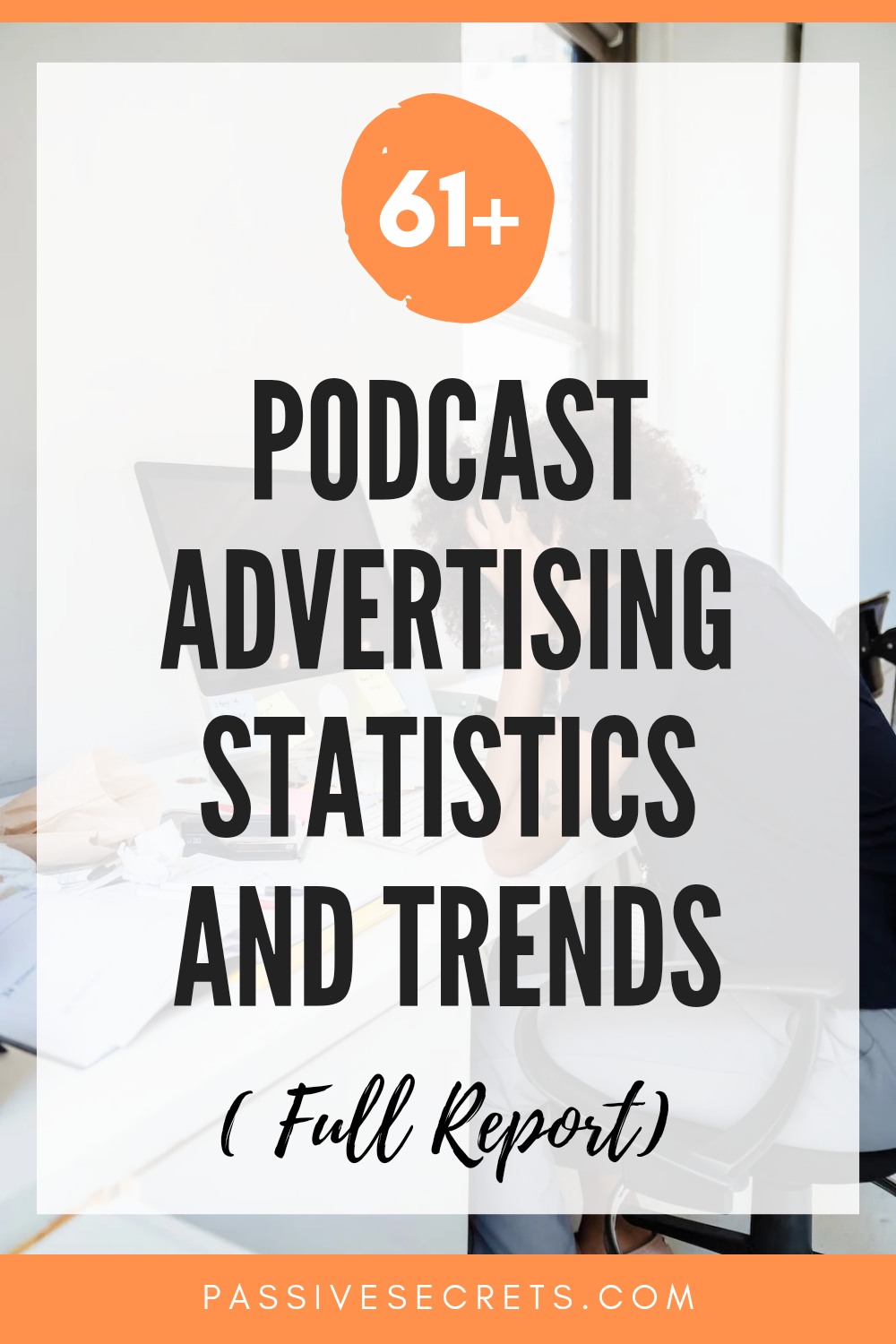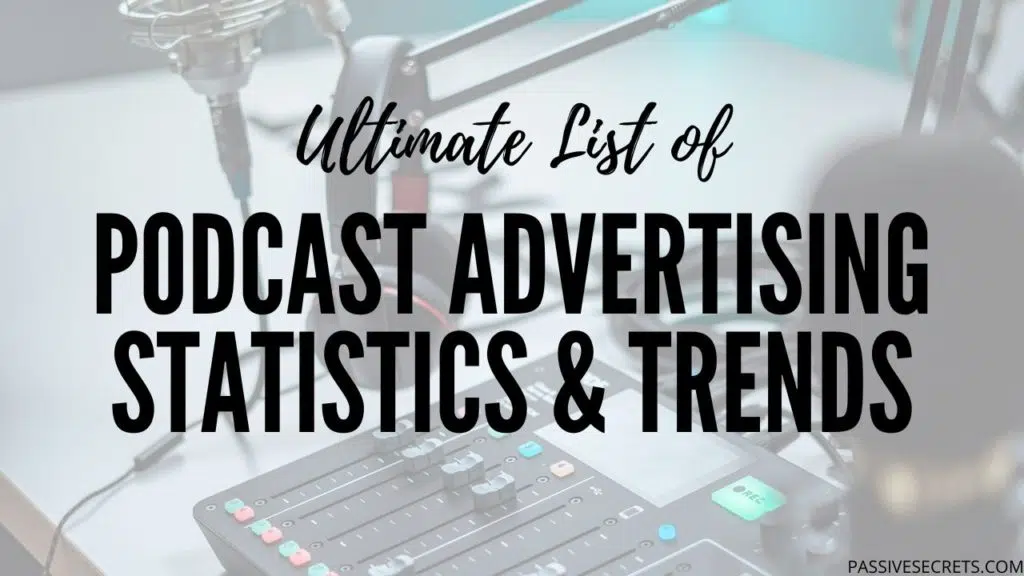
Podcasts are the latest way people all over the world now consume information. Over the last few years, podcasts have been taking over worldwide.
However, aside from entertainment, they can also be a great marketing tool.
Podcasting as an advertising medium has grown in popularity recently, and many companies are taking notice of its increasing potential. In fact, smart marketers are already reaping its benefits before it becomes too saturated with ads.
In this article, we’ll look at the most recent podcast advertising statistics you should know.
Our Top Statistic Picks On Podcast Advertising
- The average ad spend per podcast listener is estimated at £2.31.
- For every 100,000 listeners in a podcast, the ad rate spent ranges from $20 – $100.
- The average conversion rate for podcast ads is 0.08% for lead generation and 1.10% for site visits.
- A 30-minute podcast can only contain 3.8 – 4 ads. Anything more can be considered annoying by the listeners.
- Long podcast ads (over 40 seconds) caused hosts to lose subscribers.
- Over 55% of listeners get irritated when repeatedly hearing the same ad in the same podcast episode.
- 65% of surveyed podcast listeners say they listen to the whole podcast episode.
- About 25–30% of most podcast episode listeners lose interest in the first five minutes of the episode.
- Over 80% of podcast listeners do not believe that ads negatively affect the quality of podcasts.
- 43% of podcast listeners in the U.S. describe podcast ads as relevant and engaging.
- 69% of podcast listeners say podcast ads make them aware of new products and services.
- 54% of podcast listeners are more likely to purchase from a brand after hearing its advertisement on a podcast.
- About 75% of podcast listeners who purchased an item after listening to the podcast ads say they are happy with the purchase.
General Podcast Statistics
1. There are over 5 million podcast shows worldwide. (source)
2. There are over 109 million podcast downloads monthly. (source)
3. Most podcast listeners are likelier to follow the companies whose podcasts they listened to on other social media platforms. (source)
4. 14% of U.S. surveyed respondents say they listen to podcasts daily. (source)
5. Podcast ad spending in the U.S. is estimated to be $2.2 billion in 2023. (source)
6. 26% of the Australian population admit that they listen to podcasts weekly. 40% say they listen monthly. (source)
7. 74% of surveyed podcast listeners say they listen to podcasts to learn new things. (source)
8. 65% of surveyed podcast listeners say they listen to the whole podcast episode. Additionally, 68% listen to almost all the episodes they download. (source)
9. 54.1% of adults in the UK regularly listen to about 2-3 podcasts. (source)
10. 62% of podcast listeners are likelier to share snippets than the whole podcast with coworkers. (source)
11. 35% of podcast listeners say they listen to over ten different podcasts monthly. (source)
12. Over 82% of people spend 7 hours weekly listening to podcasts. (source)
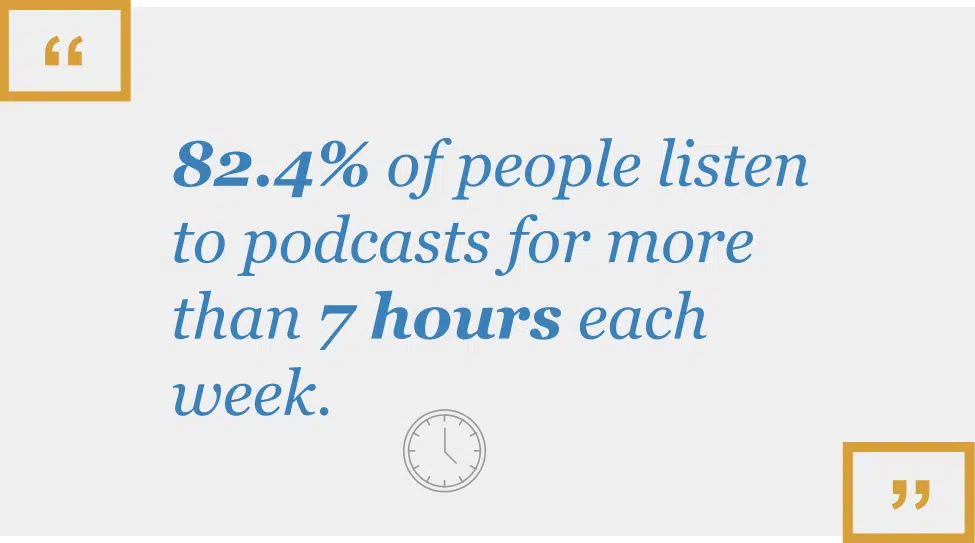
13. 92% of people prefer to listen to podcasts when alone. (source)
14. 48% of surveyed podcast listeners say they listen to podcasts while at home. (source)
15. 94% of listeners tune in to podcasts while performing other tasks. These tasks can include chores or exercises. (source)
16. Over 44% of podcast listeners in the U.K. say they listen to podcasts while travelling or driving. About 34% of podcast listeners prefer to listen to podcasts while relaxing. (source)
17. Mobile phones are the most used devices for listening to podcasts. It has 79% listening hours. (source)
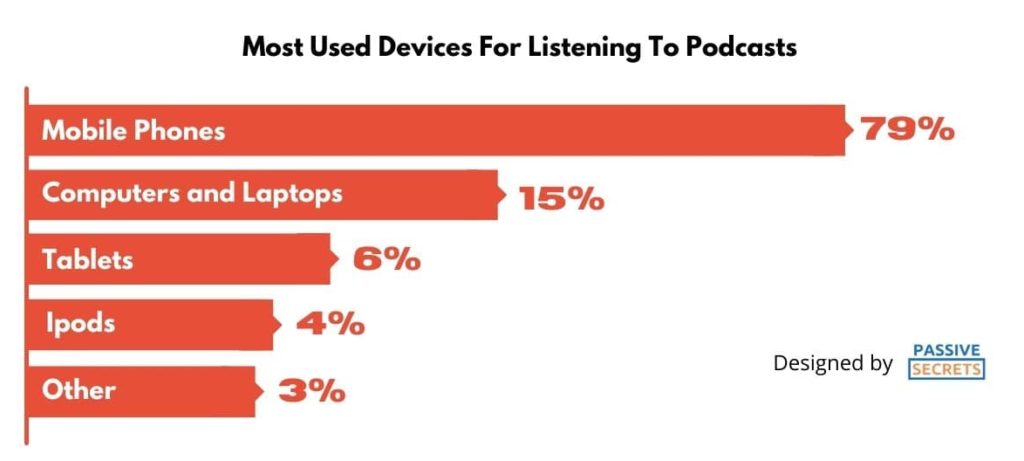
18. About 40% of podcast listeners search through the podcast app’s directory for new podcasts. (source)
19. 42% of millennials and 36% of Gen Z claim to listen to podcasts while at work. (source)
20. 67.8% of podcast listeners say that listening to educational podcasts has increased their intellectual growth level. (source)
Podcast Growth Statistics
In the previous year, podcasts have become very popular worldwide, especially in the United States of America.
People now use podcasts for various purposes, such as entertainment, education, marketing, interviews, etc.
This section shows how much podcasts have grown in the U.S. and worldwide.
21. About 62% of U.S. residents above the age of 12 have listened to at least one podcast in their lifetime. This is a growth from 2021, which was 57%. This shows that podcasts are top-rated in the U.S. (source).
22. In the U.S., the number of podcast listeners is expected to grow to 164 million by 2024. (source)
23. In 2021, there were over 19 million podcast listeners in the United Kingdom. The number is expected to increase to 28 million by 2026. (source)
24. With the rapid rise of podcasts, the global podcast industry is expected to be worth over $94 billion by 2028. This is at a Compound annual growth rate of 31.1%. (source)
25. From 2006 to 2022, there has been an increase in the population of adults who were cognizant of podcasting. The figure rose from 22% to about 79%. (source)
26. The population of podcast listeners is estimated to increase to about 28 million listeners by 2026. (source)
27. In 2021, it was estimated that there were over 525,000 active shows with over 18.5 million episodes. (source)
28. As of 2023, there were over 4.7 million podcast shows on Spotify. Apple has about 2.5 million podcasts. (source)
Podcast Advertising Statistics
29. 69% of podcast listeners say podcast ads make them aware of new products and services. (source)
30. 54% of podcast listeners are more likely to purchase from a brand after hearing its advertisement on a podcast. (source)
31. 70% of people claim to have visited an ad’s website after hearing about the product in a podcast. Another 67% of people say they talked to friends and family about the ad. (source)
32. About 3 out of 4 (75%) of podcast listeners who purchased an item after listening to the podcast ads say they are happy with the purchase. (source)
33. Over 80% of podcast listeners do not believe that ads negatively affect the quality of podcasts. (source)
34. 43% of podcast listeners in the U.S. describe podcast ads as relevant and engaging. (source)
35. Long podcast ads (over 40 seconds) caused hosts to lose subscribers. (source)
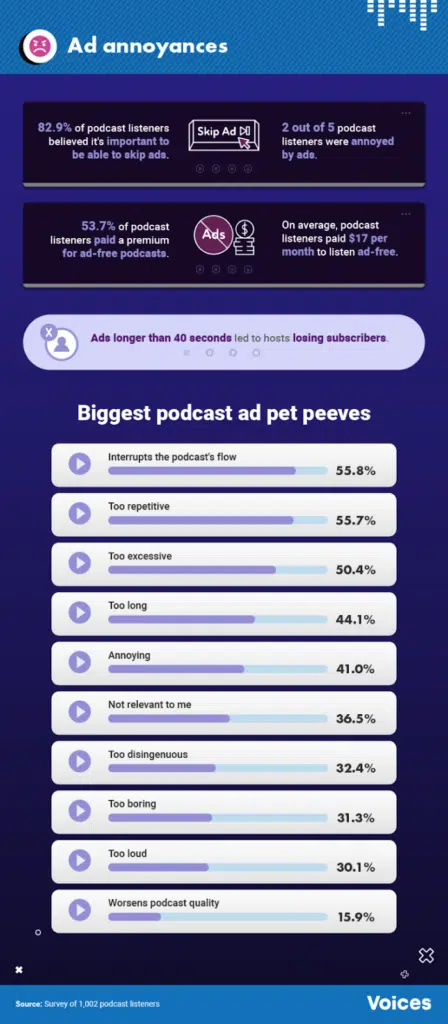
36. Over 55% of listeners get irritated when repeatedly hearing the same ad in the same podcast episode. (source)
37. A 30-minute podcast can only contain 3.8 – 4 ads. Anything more can be considered annoying by the listeners (source).
38. The number of global podcast consumers is said to have grown to about 464.7 million internet users in 2023. It is estimated to increase to 50.9 million by 2024. (source)
39. Over 56% of podcast ads revenue in 2020 came from host-read ads. This is because most listeners have come out to say that while enjoying the host’s voice and flow, they don’t want to be interrupted by pre-recorded ads. (source)
40. BetterHelp’s parent company, Teladoc Health, was the leading podcaster in the U.S., with its ad spending at $26 million. Next was Amazon, which stood at $17.5 million. (source)
41. In 2022, podcast ads generated about $1.8 billion in revenue. It is expected to reach $4 billion by 2025. (source)
42. In 2021, the total amount spent on podcast ads was $1.4 billion. Before the end of 2022, the total podcast revenue in the U.S. was estimated to reach over $2 billion. The revenue is also expected to increase to $4 billion by 2024. (source)
43. The podcast ad expenditure in the U.K. amounted to £46 million, which is expected to increase to £80 million by 2026. (source)
44. In 2021, the total digital audio (including podcasting) ad spend amounted to £23 billion. (source)
45. Over 50% of surveyed U.S. marketers say that 3% of their advertising budget will go into podcast ads. (source)
46. The average ad spend per podcast listener will continuously decrease between 2023 and 2028. (source)
47. For every 100,000 listeners in a podcast, the ad rate spent ranges from $20 – $100. This is one of the top ways podcasters earn from their podcasts. The more listeners they have, the more money they make. (source)
48. According to a detailed report, the average conversion rate for podcast ads is 0.08% for lead generation and 1.10% for site visits. (source)
49. News is the podcast genre with the highest ad revenue. It accounted for over 22% of the podcast ad revenue. (source)
50. The comedy genre is the most popular podcast genre in the U.S. Over 22% of podcast listeners in a survey affirmed that they preferred listening to podcasts that make them laugh. (source)
51. The average CPM of podcast ads for 30 seconds is $18, and for 60 seconds is $25. (source)
Podcast Demographic Statistics
52. Millennials have the highest number of podcast listeners in the U.S. (source)
53. Podcasts in the UK are more popular among young people, especially those between 26 and 35 years old. (source)
54. The UK has over 19 million podcast listeners. (source)
55. The U.S. has the highest number of podcasts, with over 123,539 active podcasts. (source)
56. 46% of monthly podcast listeners in the U.S. are women. However, men make up 53%, and non-binary take the last 1%. (source)
57. 79% of U.S. consumers above 12 years know about podcasting. (source)
58. There has been a jump from 68% of people who listened to podcasts in the US as of 2021. In 2022, it was estimated that the figure rose to 73%. (source)
59. 73% of people in the US aged 18+ who drive cars are regular podcast listeners. (source)
60. In 2021, iHeartRadio was the leading podcast publisher. It had over 377.24 million unique streams and downloads. Wondery came second with about 176.23 million. (source)
61. Spotify is the most popular app for listening to audio podcasts in the U.S. (source)
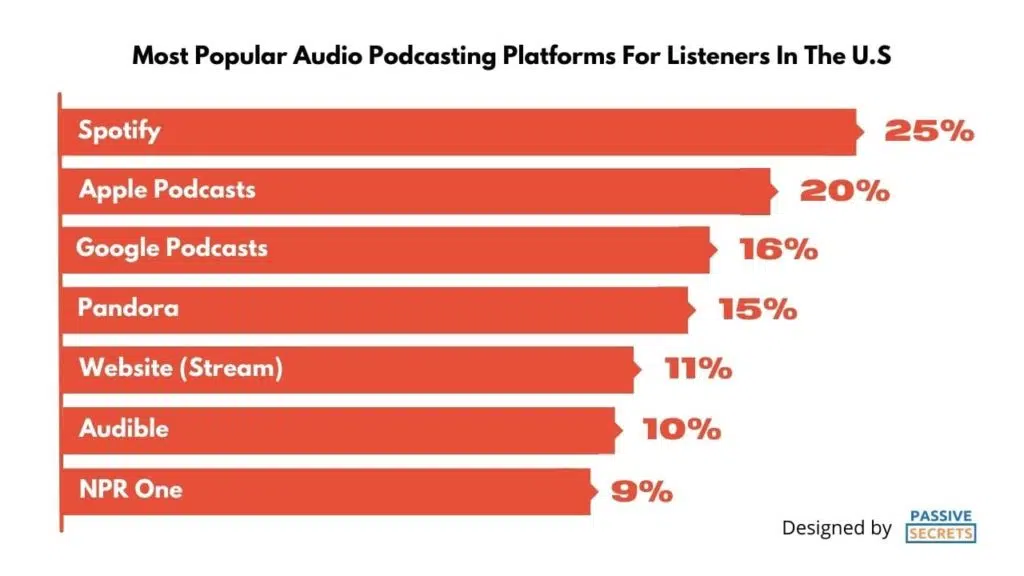
62. Spotify has spent almost $900 million on several podcast-related acquisitions. (source)
Latest Podcast Advertising Trends For 2024 And Beyond
1. More Sponsored Ads
As podcasts are becoming even more popular, companies are using this platform to increase their reach.
According to the statistics above, 75% of podcast listeners like listening to podcasts to learn new things. Therefore, marketers are taking advantage of the opportunity.
The trend of podcast ads is not dying anytime soon as more podcast listeners are rapidly growing, and podcasters want to increase their income.
The best way marketers can do this is through sponsored ads.
In these ads, the company sponsors the content for the episode, and in return, the host mentions the brand and tells the audience to check out the brand.
This is better than inserting pre-recorded ads.
2. Improved Sensory Experience
Podcasters want to attract more subscribers and possibly more advertising deals.
One of the most important ways to get things is to improve their sound quality.
Your audio quality can attract or scare away listeners. If listeners have issues hearing you, they log off or opt into another podcast.
So to prevent that, you need to improve on your gadgets.
From your sound mic to your headphones, computer/laptop, noise cancelling USB, and recording and mixing software.
You should also ensure you have strong internet access.
Furthermore, you should also ensure your content is relatable, fun, and engaging. Listeners will likely tune off after a few minutes if your content is boring.
Fresh and creative content is very important.
3. Bringing Influencers as Guests
One of the best and most trending ways to attract more subscribers is to have niche influencers as guests.
In fact, marketers prefer to advertise with podcast channels that have high engagement and use their niche influencers.
Influencers have a strong following that can attract more listeners and increase a brand’s reach.
As a podcast host, it is crucial to have a niche. This will help you know which influencers to invite and what audience to attract.
With influencers, you can create highly engaging content and establish yourself as an authority in your niche.
People tend to listen to people with authority and a strong community. You can leverage that.
4. Making Data-driven Decisions
We’ve all heard that creators who know their audience well can create some of the most valuable and immersive content.
One of the best ways to do so is to use analytics and data in the following ways:
To stay on top of your game, fine-tune your information based on prompt, effective, and marketable strategies supported by data.
Research trending topics and search terms relevant to your intended audience to increase engagement.
Plan your content ahead of time to ensure you cover topics at the best possible time.
Also, learn about your listeners’ demographic profile (who listens to you, what they want to hear, and why) and effective marketing strategies tailored to your niche.
As the podcast industry is getting even more popular, there is no doubt that it is also getting more competitive. So you have to stay ahead of your game if you want to win.
5. Live Podcasting on Social Platforms
As social media platforms like Facebook, Instagram, and Twitter seek to remain influential and important to their subscribers, they turn to audio to broaden their offerings.
Twitter launched “Twitter Space” in November 2020. This allows users to have live audio conversations.
In 2021, Facebook followed suit by launching a “Soundbites” platform, which features short audio clips in a bite-size format, i.e. under 5 mins. This will be an exciting way for creators and subscribers to record and broadcast personal experiences, jokes, tips, and so on – as well as a potential new space for brands to advertise.
Live podcasts are a new way to increase audience engagement and generate an extra revenue source.
It helps to connect with an audience personally, strengthening your community as a brand.
It also allows a free flow of interaction and collaboration between the audience and partners.
6. Voice Search Optimization
Voice searches are now even preferred to Google searches.
This is because it is more convenient when giving commands or searching for things on the internet.
In fact, about 71% of consumers prefer voice searches to written searches.
The utility of voice commands will only grow in popularity over time. Households now have AI speakers, allowing more people to conduct voice searches.
But how can you ensure that your podcast can be visible in search results when a potential listener searches for podcasts with similar content?
A high SEO score is the answer. This involves using relevant keywords in your marketing materials.
To reach their target audience and land on the right results page, podcasters must be specific about their content.
Another consideration is the nature of these voice searches. People frequently ask questions to find answers to what they are looking for.
Therefore, optimizing words like “what your podcast is about” or “who it’s for,” as well as semantically related keywords, will improve its searchability.
7. Niche Podcasting
The concept of niche podcasting stays the same as it involves the selection of a particular field or topic to create content consistently.
In recent years, there has been a massive increase in podcasts catering to a specific audience’s specific interests and needs.
Niche podcasting is a trend that helps advertisers to reach a highly targeted demographic.
It also establishes the podcaster as an authority, thus helping advertisers identify and partner with niches that best align with their product or service.
8. Increased Competition Between Podcast apps
With the growing popularity of podcasts, more and more apps are entering the market, striving for a share of the listenership.
As a result, podcast platforms are continuously innovating and modifying their features to attract both podcasters and advertisers.
This provides a wider package of opportunities for content creators to expand their shows and for advertisers to achieve their target audience effectively.
9. Podcast Monetization
As podcasting has now become a lucrative industry, creators are also uncovering diverse ways to monetize their shows.
Podcasters are exploring various paths to generate revenue, from ad placements to sponsorships, subscription models, and even merchandise sales.
This opens up new possibilities for advertisers to collaborate with podcasters and tap into their loyal fan bases, amplifying their brand reach.
Building a supportive community is the foundational thing to do to monetize your podcasts.
After doing this, locating and utilizing platforms such as Podbean, Anchor, RSS.com, Captivate, Buzzsprout, etc, goes a long way in helping to monetize your content.
10. Effective Storytelling as the Heart of Podcasting
Podcasts are known for their intimate and immersive storytelling experiences, which intrigue listeners. Without the right stories being told, there just might be no attraction.
Advertisers now recognize the significance of integrating storytelling techniques in their ad campaigns.
Advertisers can seamlessly integrate their brand messages into the content by crafting compelling narratives that resonate with the podcast’s audience.
This would help to create a more engaging and authentic listening experience for your audience.
Frequently Asked Questions
1. Why Do Podcasts Fail?
Although there are over 2 million podcasts, not all of them last longer than three episodes, most fail. The primary reason is that podcasters experience burnout.
In another case, some podcasts that stopped airing were only created for a specific reason/goal.
Once the goal has been achieved, the host may close the podcast and focus on something else. These types of podcasts usually last for six months.
Aside from burnout, one of the significant reasons podcasts fail is that most podcasters find it quite challenging to connect with their audience.
While listening to you, your audience can quickly get bored and log off if you are not engaging with them.
This means that your content has to be relevant and relatable. It should also be insightful. People are eager to learn new things when they listen to you talk.
Take a particular niche and specialize in it. Don’t do too much and end up overcrowding your episodes so people get overwhelmed and lose interest.
You can take them on a journey; each episode explains a topic in your niche.
2. How Much Can You Make With Podcasting?
Podcasting has become a popular side hustle and is here to stay. According to Podcast AI, podcasters can earn between $10,000 – $500,000 per episode. This is very huge.
However, you need to consider some important factors to earn a good income from podcasting. These factors include
- The effort you put into your podcast show
- If you will sell sponsorships
- How well do you promote your podcast to a potential audience?
3. How Do Podcasters Earn Money?
Podcasters earn their money in various ways. One of the most prominent ways is through sponsored ads.
Because podcasts are now trending and gathering a large audience, marketers are taking advantage of this opportunity to increase their reach.
It is now part of their digital marketing strategy.
In ad sponsorships, the host will mention the company a few times during the episodes.
The host will also encourage the audience to visit the company’s website or check them out online.
The sponsors pay on a “Cost per Thousand” or “Cost per Mile” (CPM) basis. This means the more downloads you get, the more money you make.
Typically, the charge is usually $18 – $50 CPM.
Other ways of earning through podcasting include
- Affiliate sales
- Direct support from fans for the show
4. What Are The Most Popular Podcast Topics?
There are various topics discussed in podcasts. But the most popular ones include:
- Comedy
- News
- Sports
- Business and finances
- Relationships
- True crime
- Health and Fitness
According to Statista, the top 5 are comedy, news, sport, health and fitness, and true crime.
5. How Can I Measure My Podcast’s Success?
You can measure your podcast’s success by various factors. The goal is to have a large and engaged audience. Therefore, these factors include:
- Total number of audience/listeners
- Number of downloads per episode
- Audience reviews
- Sponsors and advertisements (if you have none, then you need to reconsider how to attract brands)
- Social media and website traffic (this also includes traffic for the sponsors)
- Audience engagement (if you have fewer engagements, it means you may be doing something wrong)
- Referrals (how many of your audience are referring to you?)
If your podcast has about 5,000 listeners per episode, you can say you have a successful podcast.
As a podcaster, measuring the success of your podcast is very important. It would help you improve your content and delivery, thus attracting a more enthusiastic audience.
Now that podcasts are increasing in number, they are also becoming very competitive, so you need to put out your A-game and grow your audience.
Conclusion
You now know what to expect from the podcast industry from the podcast advertising statistics and trends in this article.
Podcasting is a brilliant way to reach large audiences. The industry is expected to grow even more than it is now.
With this, marketers want to start incorporating podcast ads into their marketing strategy. It would help if you also took advantage of it.
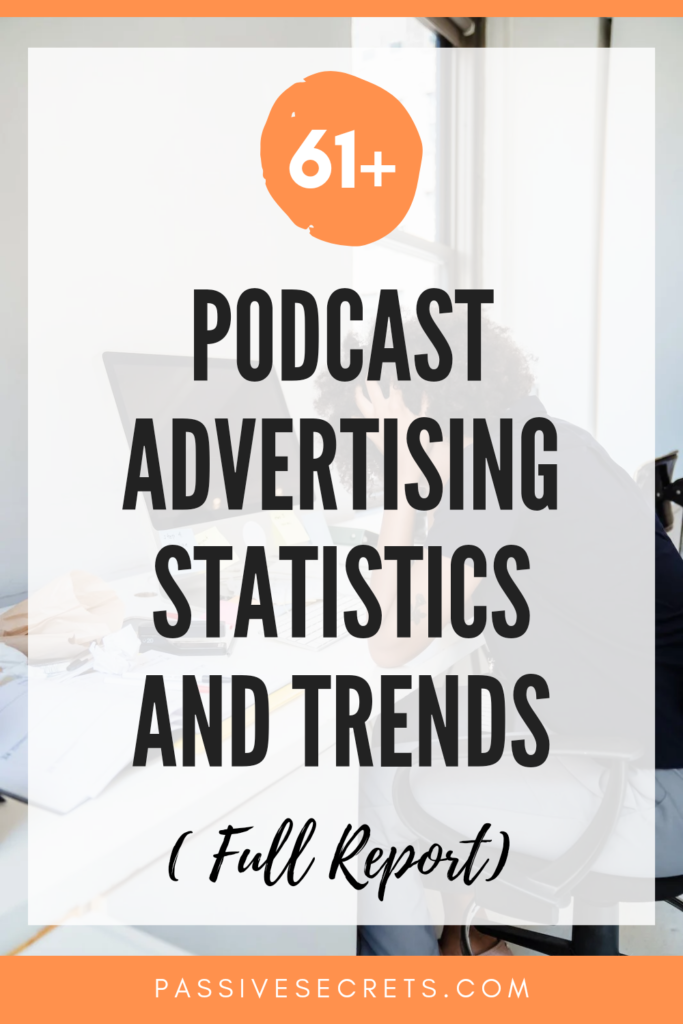
Related Posts:
- 42+ Latest Multichannel Marketing Statistics and Trends
- 81+Sales Funnel Statistics To Increase Conversion Rates (Complete List)
- 67+ Best Virtual Event Statistics & Benchmarks All Marketers Need to Know
- 55 Useful Direct Mail Marketing Statistics, Trends, and FAQs For 2024
- 75 Pay-Per-Click Statistics, Trends & Benchmarks (Amazon, Social, Google & Search Ads Stats)
- 45+ Useful Omnichannel Marketing Statistics, Data, Trends & Strategies to Boost Sales Results
- 110+ Social Media Advertising Statistics and Trends
- 41+ Best Copywriting Statistics & Trends to Increase Conversion in 2024 And Beyond
- 47+ Top Multi-level And Network Marketing Statistics, Facts & Trends
- 50 Useful Organic Vs Paid Search Statistics To Know in 2024
- 100+ Top Digital Marketing Vs Traditional Marketing Statistics To Know in 2024
- 51+ B2B Lead Generation Statistics, Facts, and Benchmarks All Marketers Need to Know

